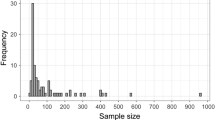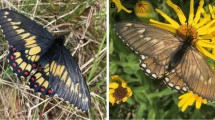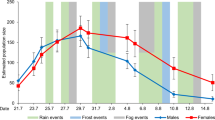Abstract
The endangered American burying beetle, Nicrophorus americanus, was monitored on Block Island, RI, USA, from 1991–2003 using mark-recapture population estimates of adults collected in pitfall traps. Populations increased through time, especially after 1994 when a program was initiated that provided carrion for beetle production. Beetle captures increased with increasing temperature and dew point, and decreased with increasing wind speed. Short distance movement was not related to wind direction, while longer distance flights tended to be downwind. Although many individuals flew considerable distances along transects, most recaptures were in traps near the point of release. These behaviors probably have counterbalancing effects on population estimates.
Similar content being viewed by others
References
Amaral M, Kozol A, French T (1997) Conservation status and reintroduction of the endangered American burying beetle. North East Nat 4:121–132
Bailey NTJ (1951) On estimating the size of mobile populations from recapture data. Biometrika 38:293–306
Bedick JC, Ratcliffe BC, Hoback WW, Higley G (1999) Distribution, ecology, and population dynamics of the American burying beetle [Nicrophorus americanus Olivier (Coleoptera: Silphidae)] in south-central Nebraska, USA. J Insect Conserv 3:171–181
Kozol A (1991) Annual monitoring of the American burying beetle on Block Island. Unpublished report to the U.S. Fish and Wildlife Service. Department of Biology, Boston University, Boston, MA
National Climatic Data Center (2003) Integrated surface hourly weather observations (ISHWO), U.S. Department of Commerce, National Oceanic and Atmospheric Administration, Asheville, NC
Raithel CJ (2002). Small island, big birds: avian biomass and the persistence of the American burying beetle on Block Island. In: Paton PW, Gould LL, August PV, Frost AO (eds) The ecology of Block island. Rhode Island Natural History Survey, Kingston RI, pp. 197–202
Rohlf FJ, Slice DE (1999) BIOMstat for Windows, version 3.3. Exeter Software, Setauket, NY
Sikes DS, Raithel CJ (2002) A review of the decline of the␣endangered American burying beetle (Silphidae: Nicrophorus americanus Olivier). J Insect Conserv 6:103–113
Southwood TRE (1978) Ecological methods with particular reference to the study of insects. Chapman and Hall, London
Acknowledgements
This project was supported, in part, by the Endangered Species Act, Section 6 cooperative agreement between the U.S. Fish and Wildlife Service and the R.I. Division of Fish and Wildlife, Project E-1. The Block Island office of The Nature Conservancy and the families of Keith and David Lewis provided valuable logistical support for this work. The following individuals assisted with field surveys: Michael Amaral, Miles Amaral, Scott Comings, Richard Enser, John Raithel.
Author information
Authors and Affiliations
Corresponding author
Additional information
The U.S. Goverment's right to retain a non-exclusive, royalty-free license in and to any copyright is acknowledged.
Rights and permissions
About this article
Cite this article
Raithel, C.J., Ginsberg, H.S. & Prospero, M.L. Population trends and flight behavior of the American burying beetle, Nicrophorus americanus (Coleoptera: Silphidae), on Block Island, RI. J Insect Conserv 10, 317–322 (2006). https://doi.org/10.1007/s10841-006-9001-5
Received:
Accepted:
Published:
Issue Date:
DOI: https://doi.org/10.1007/s10841-006-9001-5




